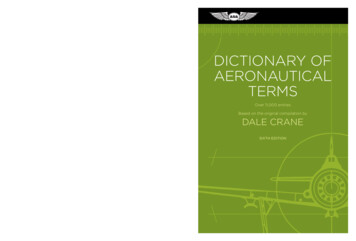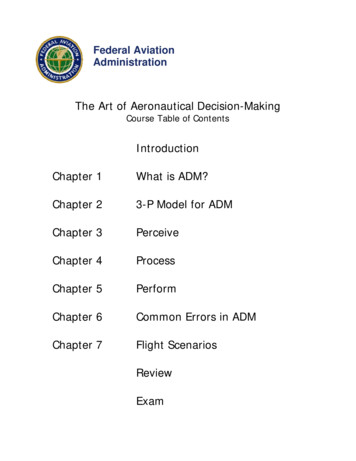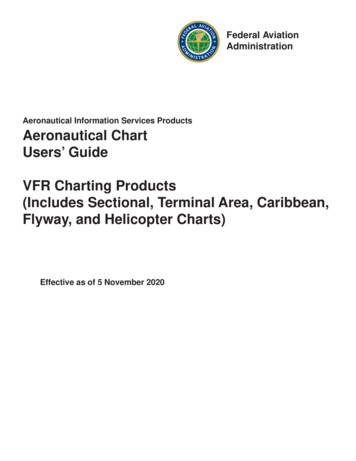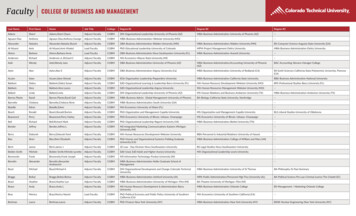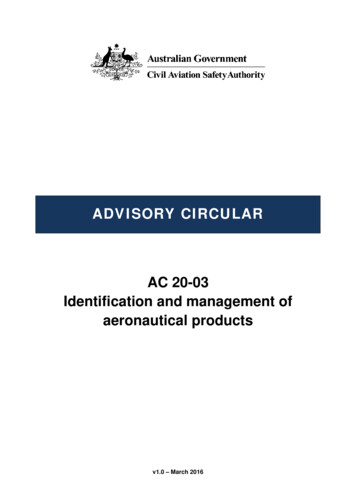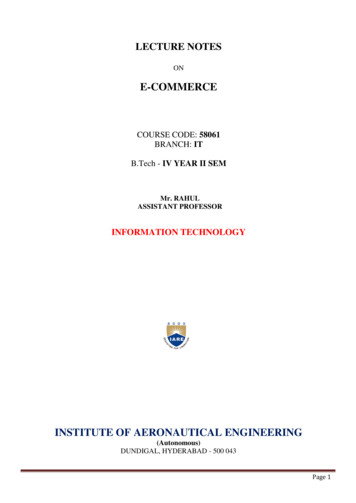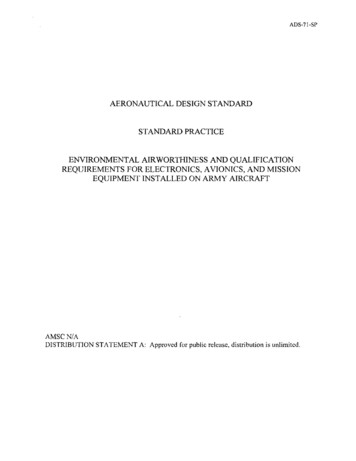
Transcription
ADS-71-SPAERONAUTICAL DESIGN STANDARDSTANDARD PRACTICEENVIRONMENTAL AIRWORTHINESS AND QUALIFICATIONREQUIREMENTS FOR ELECTRONICS, AVIONICS, AND MISSIONEQUIPMENT INSTALLED ON ARMY AIRCRAFTAMSCN/ADISTRIBUTION STATEMENT A: Approved for public release, distribution is unlimited.
ADS-71-SPAERONAUTICAL DESIGN STANDARDSTANDARD PRACTICEENVIRONMENTAL AIRWORTHINESSAND QUALIFICATION REQUIREMENTS FOR ELECTRONICS, AVIONICS,AND MISSION EQUIPMENT INSTALLED ONARMY AIRCRAFTFUNCTIONALDMSIONSUBMITTED BY: II QJ2Iv } Dr. William LewisDirector of AviationEngineering1v12- , d6 Jk APPROVED BY:Randall B. Harkinsk\1COM and PEO, AviationStandards Exeeutive'1 t)C.r 01DATE:11
ADS-71-SPCertification RecordPrepared by:Doeument Identifier and Title:ADS-71-SP, STANDARD PRACTICE FOR ENVIRONMENTAL AIRWORTHINESS ANDQUALIFICATION REQUIREMENTS FOR ELECTRONICS, AVIONICS, AND MISSIONEQUIPMENT INSTALLED ON ARMY AIRCRAFTRationale for Certification:Decision'General Type--::c-.Specification. sion (-.ILl Certification.PerformanceDetail!Interface StandardStandard Practice-.Ii:Desi an StandardITest Method StandardProcess StandardI Handbook (non-mandatory use)IIi;StandardIIHandbookAlternative ActionConcurn .".w., " - -v'.,.-'1e::2 } ! Dr. William Lewlsiiiv1/Non-concur: ;-iDate' - - - i:r(71ftJ7'i i1/Zt/691ft! 09
ADS·71·SPFOREWORD1. This standard is approved for use by all Departments and Agencies of the Department ofDefense (DoD).2. This Aeronautical Design Standard (ADS) establishes the requirements and verificationprocesses through which airworthiness and environmental qualification of avionics, electronics,or other related mission equipment is accomplished.3. Comments, suggestions, or questions on this should be addressed to the Aviation EngineeringDirectorate (AED), Mission Equipment Division (MED), Electronics Branch, EnvironmentalTeam, Bldg. 4488, Redstone Arsenal, Huntsville, AL. 35898-5000IV
ADS-71-SPTable of Contents1SCOPE. 1I. J1.22GENERAL. . 1PURPOSE. 1APPLICABLE DOCUMENTS . 12.12.2GENERAL. 1GOVERNMENT DOCUMENTS . 12.2.12.2.22.32.43Specifications. Standards and Handbooks. . . . 1Other Government Documents, Drawings. and Publications. . . 2NON-GOVERNMENT PUBLICATIONS . 2ORDER OF PRECEDENCE. 3DEFINITIONS . 33.1EQUIPMENT CLASSIFICATIONS . 33.1.13.1.23.1.33.2Flight Critical EqUipment. .Flight Essential Equipment. .Safety Crilieol Equipment. . . 3. 3. . 3GENERAL. .3.2.13.2.23.2.33.2.43.2.53.3. . 3Full Qualification. . . 3Fielding. . . . . . . . . . . . . . . . . . . . . . . . . . . . . . . . . . . . . . . . 3Multi-Platform. . . . . 3Platform Specific. . . 3Safety ofFlight (SOF). . . 3ACRONYMSIABBREVIATIONS . 4GENERAL REQUiREMENTS. 44SELECTION or TESTS. 4SEQUENCE OF TESTS. 5TEMPERATURE/ALTlTUDE TEST REQlJIREMENTS . 54.14.24.34.3.14.3.24.4Platform Specific Requirements. . 5Multi-Platform Requirements. . 5EQUIPMENT VERIFICATION CRITERIA. . 54.4.14.4.24.43Test.Analysis. . .Similarity. . . . 5. 5. . 5DETAILED REQUiREMENTS . 655. JENVIRONMENTAL TEST REQUIREMENTS FOR A SOF AIRWORTHINESS RELEASE (AWRJ. 65.1.1SOF - Detailed Test Requirements .2.7SOF - Low Pressure (Altitude) OperationaL. . 7SOF - Low Temperature Operational. . 7SOF - High Temperature·- Operational. ,. ,.,. ,. " .7SOP - Explosive Atmosphere.". . " . ,. "".".7SOF· Vibration. . . 8SOF· Shnck Crash Hazard. . . 8SOF· Gunfire Shoek. . 8H. '. " " " " ".ENVIRONMENTAL TEST REQUIREMENTS FOR A F1ELDlNG A WR. g5.2.1Fielding - Detailed Test Requirements. . /05.2.1.15.2.1.252.1,3Fielding - Low Pressure (Altitude) - Storagel Air Transport. " . " . ,,, .10Fielding - High Temperature - Storage (Non Operational) . " ,. " . . 10Fielding . Low Temperature - Storage (Non-Operational). ." . ,,,.,,,, . ,,. 115.2. 1.4Fielding· Rain . II " . . . . . . . . . , , . . .V
ADS·71·SP5.2.1.4.1fielding· Blowing Rain. . . II52.1.4.2Fielding. Dripping Rain. . II5. 2.1.5 Fielding· Sand and Dust. . . . 115.2.1.6 Fielding· Explosive Atmosphere. II5.2.1.7 Fielding - Vibration . " . " .i15.2.1.8 Fielding. Shock - Functional. . . II5.2.1.9 Fielding. Shock - Crash 1. lazard . II5.2.l.IOFielding. Gunfire Shock. . 125,2.l.11Fielding - Combined Temperature, Humidity, Vibration, and Altitude . ". " ." . 12ENVIRONMENTAL TEST REQUIREMENTS FOR FULL QUALIFICATION. 12u5.35.3.1 ., . . . . . . . . . . . . . . . . . . . . . . . . . . . . . . . . . . . . . . . . . n. ". "Full Qualification Detailed Test Requirements . . . . 145.3.1.1 Low Pressure (Altitude). . . 145.3.1.1.1Low Pressure (Altitude) Operational. . 145.3.1.1.2Low Pressure (Allitude) . Storage! Air Transport. . . 145.3.1.1.3Low Pressure (Altitude) - Rapid Decompression. .14. 145.3.1.2 High Temperature. . . . .5.3.1.2.1High Temperature Operational. . .145.3.1.2.2High Temperature - Storage (Non.Operational). . . . 145.3.1.3 1.ow Temperature. . . . .15Low Temperature Operational. . . 155.3.1.3.15.3.1.3.2Low Temperature Storage (Non·Operational). . . . 155.3.1.4 Temperature Shock.155.3.1.5 Contamination by Fluids. . . 165.3.1.6 Solar Radiation (Sunshine). . . 165.3.1.7 Rain. . 165.3.1.7.1Blowing Rain .".,,,,,,. ,. q, . ,,.,', .,., . ,"" . 165.3.1.7.2Dripping Rain. . . . 165.3.1.8 Humidity. . . . . 165.3.1.9 Fungus. . . . 165.3.1.10Salt Fog. 175.3.1.11Sand and Dust. . . . 175.3.1.12Explosive Atmosphere. . . . . 175.3.1.l3Immersion. . . . . 175.3,1.14Acceleration., .,,, .,. ,,,. ,. ,.,. " . " . "." . ".,. " . ",.175.3.1.15Vibration. . . . 175.3.l.I6Shock. . 175.3 . l.I 6. IFunctional Shock. . 175.3.1.16.2 Transit Drop Shock . . . 185.3.1.16.3 Crash Hazard Shock. . . . . . 185.3.1.16.4 Bench Handling Shock. . . . . 195.3. 1.17Guntire Shock. . . 195.3.1.18Combined Temperature. Humidity. Vibration. and Altitude. 195.3.1.19Icing/Freezing Rain. . . 19UNMANNED AIRCRAFT SYSTEM (UAS) . 195.45.4.!UAS Levell AirwOrlhiness Full QlIalification Environmental Test Reqllirements. . 195.4.1.1 UAS Levell AirlAortbiness Full Qualification Detailed Environmental Test Requirements. " . 205.4.1.1.1Rail I mpacl. . . . 20' '5.4.25.4.35.4.46UAS Levell! Airworthiness Fielding Environmental Test Requirements. 20UAS Leve/Ill Airworthiness Safety ofHight Environmental Test Requirements. . 21Airborne versus Ground Equipment. . . . . 22NOTES. 226.16.26.36.46.5ACQUISITION REQUIREMENTS . 22TEST PLANS/PROCEDURES. 22TEST REPORTS . 23SYSTEM·LEVEL QUALIFICATION VERSUS COMPONENT QUALIFICATION. 23CO 1BINED ENVIRONMENTS TEST METHOD 520.3 VERSUS INDIVIDUAL TEST METHODS. 24APPENDIX A: GENERAL LABORATORY TEST METHOD GUIDELINES . 25A, ISTANDARD AMBTENT TEST CONDITIONS . ,." . " . ,.,.,''''', . .,.,., . " . " ., . " . 25VI
ADS-71-SPA.2A.3CONTROLLED AMBIENT TEST CONDITIONS .25TOLERANCES.25A3.1A.3.2A.3.3A.3.4Temperature Tolerance. . 25Operating Temperature Stabilization. 25Non-Operating Temperature Stabilization. . . 26Pressure. . 26A.3.5Humidity. . . . 26A.3.6 Vibration Amplitude . . . 26A.3.7 Vibration Frequency.26A.3.8 Acceleration. . . 26A3.9 Time . . . . . . . 26A.3.10Air Velocity. . . . .26APPENDIX B: EXTERNALLY MOUNTED ANTENNA . 27APPENDIX C: TEST EQUIPMENT . 28APPEJliDlX D: FUNCTIONAL CHECK PROCEDURE (FCP) . 30D.IFUNCTIONAL CHECK PROCEDURE (FCP) .30D.l.l Pre-Test Fep. . 30D.I.2 During Test Fep. . 30DJ3 Past-Test Fep . . 30Vll
ADS-7J-SP1 SCOPE. This Aeronautical Design Standard (ADS) applies to all new and/or modifiedavionics, electronics, and mission equipment installed or affiliated with Army aircraft andcontains the environmental test requirements for satisfying the various phases of airworthinessfrom Safety of Flight (SOF) through full qualification.1.1 General. The operational requirements for Army aircraft components ultimately originatefrom the eser who specifies the performance criteria. Frequently included in these performancecriteria is the ability of the component to operate within its design specifications under specificinduced and natural environments. For optimum results, a Life Cycle Environmental Profile(LCEP) should be generated by the combat/materiel developer to define the most extremeenvironmental stressors or combination of environmental stressors that a component will beexposed to during its service life. The LCEP supports the User specified performance criteriathereby influencing the design and test phases of the component developmental process. MIL·STD-810, Task 402 (Life Cycle Environmental Profile (LCEP)) explains this process in detail.After the engineering design phase of the component LCEP has been completed, the componentis subjected to specific environmental testing to verify the design satisfies the intendedperformance and airworthiness/qualification requirements as defined in AR-70-62. The primarygoal of this ADS is the definition of environmental requirements. Among qualificationmethodologies, the preferred is testing, but other methods such as similarity or analysis are alsoaccepted.1.2 Purpose. This ADS establishes the requirements and verification processes through whichairworthiness and environmental qualification of avionics, electronics, or other related missionequipment is accomplished.2APPLICABLE DOCUMENTS2,1 General. The documents listed in this section are specified in sections 3,4, or 5 of thisstandard. This section does not include documents cited in other sections of this standard orrecommended for additional information or as examples. While every effort has been made toensure the completeness of this list, document users are cautioned that they must meet allspecified requirements of documents cited in sections 3, 4, or 5 of this standard.2.2Government Documents2.2.1 Specifications, Standards and Handbooks. 'The following specifications, standards, andhandbooks form a part of this document to the extent specified herein, Unless otherwisespecified, the issues of these documents are those cited in the solicitation or contract.MIL-STD-810Test Method Standard, Environmental EngineeringConsiderations and Laboratory TestsMIL-PRF -28800General Specification for Test Equipment for Use withElectrical and Electronic Equipment(Copies of these documents are available online at http://assist.daps.dla,mil/guicksearch/.)1
ADS-71-SP2.2.2 Other Government Documents, Drawings, and Publications. The following otherGovernment documents, drawings, and publications form a part of this document to the extentspecified herein. Unless otherwise specified, the issues of these documents are those cited in thesolicitation or contract.AR70-62Airworthiness Qualification of U.S. Army AircraftSystems.ADS-27-SPAeronautical Design Standard, Requirements forRotorcraft Vibration Specifications, Modeling andTesting(Copies ofthese documents are available online andardAero. hIm orhttp://www.apd.army.millUSAPA PUB pubrange P.asp2.3 Non-Government Publications. The follov.,'ing documents form a part of this documentto the extent specified herein. Unless otherwise specified, the issues of these documents arethose cited in the solicitation or contract.RTCAlDO-160Enviroumental Conditions and Test Procedures forAirborne Equipment(Copies of this document are available online at: http://www.rtca.org.)2.4 Order of Precedence. Unless otherwise noted herein or in the contract, in the event of acontlict between the text ofthis document and the references cited herein, the text of thisdocument takes precedence. Nothing in this document, however, supersedes applicable laws andregulations unless a specific exemption has been obtained.33.1DEFINITIONSEquipment Classifications.3.1.1 Flight Critical Equipment. Generated anomalies involving this equipment would causeimmediate or almost immediate loss of aircraft control or unsafe situations with loss of life alikely occurrence.3.1.2 Flight Essential Equipment. Generated anomalies involving this equipment couldcause an emergency landing with possible damage to the aircraft, or would cause the pilot to takeother emergency action. Injury or loss of life is possible.2
ADS-71-SP3.1.3 Safety Critical Equipment. Generated anomalies involving this equipment would causea safety hazard to personnel or to the aircraft.3.2General.3.2.1 Full Qualification. Full Qualification is defined as fonnal compliance with this ADSand other technical specifications cited in the contract. Equipment will be considered fullyqualified when it has successfully demonstrated compliance to all fonnal qualification testrequirements. Refer to Section 5.3 for Full Qualification Test Requirements.3.2.2 Fielding. In this ADS, Fielding is defined as a number of aircraft fielded for a period oftime designated to fulfill a specific mission in the field. A fielding Airworthiness Release(A WR) is valid for the mission duration and is terminated upon transfer of the designatedaircraft, changes in equipment configuration, or upon issuance of a later A WR, whichever occursfirst. Refer to Section 5.2 for Fielding Test Requirements.3.2.3 Multi-Platform. Multi-platfonn is defined as equipment that is planned or has thepotential for use on more than one specific type/model U.S. Annyaircraft.3.2.4 Platform Specific. Platform specific is defined as equipment planned for use on one (I)specific type/model U.S. Army aircraft platfonn.3.2.5 Safety of Flight (SQF). In this ADS, Safety of Flight is defined as the first flight,limited experimental test flights, User evaluations, or ferrying flights for the purpose of gatheringsystem data, verifying system operation of newly designed or modified equipment, or moving anaircraft from one location to another. A SOF A WR is valid until the date identified on thespecific A WR and is terminated upon transfer of the subject helicopters, changes in equipmentconfiguration, or upon issuance of a later AWR, whichever occurs first. Refer to Section 5.1 forSOF Test s CelsiusDegrees FahrenheitADSAEDAWRAeronautical Design StandardAviation Engineering DirectorateEEMPFAAFCPAirworthiness ReleaseEnvironmental Engineering Management PlanFederal Aviation AdministrationgFunctional Check ProcedureAcceleration due to gravityHzUnit of frequencylAWIn HgIn Accordance WithInches of Mercury3
ADS-71-SPkPaKilopascalLCEPLife Cycle Environmental ProfileLRULine Replaceable UnitMEDMission Equipment DivisionOEDOperational Environment DocumentationRHRelative HumidityRTCASOFSRSRadio Technical Commission for AeronauticsUASUUTUnmanned Aircraft SystemSafety of FlightShock Response SpectrumUnit Under Test4
ADS-71·SP4 GENERAL REQUIREMENTS. Environmental testing shall be in accordance "'ith thetcst methodologies, procedures, and requirements as set forth in MIL-STD-81 O. Equipmentwhich has had previous test approvals in meeting commercial or other airworthiness qualificationprograms may bc acccpted for Army approval to the extent that their individual test requirementsand methods satisfies the environmental technical requirements as set forth in this ADS. Forgeneral laboratory test method guidelines, see Appendix A.4.1 Selection of Tests. Normally, specific and comprehensive environmental requirementsshould be identified by the User community (combat/materiel developer) at the beginning of theacquisition process from which LCEP(s), Environmental Engineering Management Plans(EEMP(s), Operational Environmental Documents (OED(s), approved Aircraft Specifications,etc., arc generated. However, if environmental requirements are not clearly specified from thesesources, the basic test requirements as contained in this ADS shall apply. Test requirementsshall be tailored depending on specific mission requirements.4.2 Sequence of Tests. If a specific test sequence has not been specifically identified by theprocuring office or agency, the test order as identified in MIL-STD-810 shall be applied. It ishighly recommended that for eonducting the explosive atmosphere test, vibration, shock, andtemperature tests be conducted on the same unit prior to the Explosive Atmosphere test4.3Temperature/Altitude Test Requirements4.3.1 Platform Specific Requirements. Cnless platform specific environmental testrequirements have been specified in a government approved requirements document for USArmy aircraft, the temperature/altitude requirements in TABLE I spall apply.4.3.2 Multi-Platform Requirements. The temperature/altitude requirements in TABLE Ishall apply to multi-platform components and represent the most extreme environmentalconditions cited in aircraft specifications across platforms.Low TemperatureTABLE I.Temperature/Altitude Test ParametersStorage (Non-Operational)-62 C (-80 F)Low Temperature Operational-54 C (-65"F)High Temperature Operational 71 C ( 1 60 F)High Temperature 85 C ( 185 F)Storage (Non-Operational)Low Pressure (Altitude)Storage/ Air TransportAltitude Operational15,240m (50,000 ft)6,096m (20,000 ft)5
ADS-71-SP4.4 Equipment Verification Criteria. Aircraft equipment may satisfy environmentalrequirements by one or a combination of any of the following verification methods:4.4.1 Test. Verification by test is the standard and most accurate method of verification.Testing often proves to be the quickest and least expensive of the verification methods.4.4.2 Analysis. Verification by analysis will be accepted whenever perceived to be feasible bythe procuring agency.4.4.3 Similarity. Verification by similarity shall include the appropriate data on the verifiedcomponent to which similarity is being claimed. The similarity argument shall detail thesimilarity rationale based on the data described below. The minimum data requirements andrules for similarity are as follows:a. The two components being compared to each other shall be operated in similarenvironments with similar performance and duty cycle requirements. Significantdifferences in operating environments shall be discussed and rationale for similarityprovided.b. Test results shall verify that the component to which similarity is being claimed shallhave passed tests that are the same or more stringent than the test requirements beingsubstantiated. Differences in test environment, criteria, or method shall be clearlydelineated. If test failures occurred during verification, such shall be properlydocumented, including corrective action and successful retest.c. The component to be verified shall be similar to the previously verified component.Similarity statements shall provide a detailed accounting of all differences between thetwo components. Detailed substantiating data shall also be required to be provided in theform of similarity arguments, similarity rationale, detailed comparative diagrams(photos, sketches), etc., that clearly depict every aspect (on a part-to-part basis) of theequipment to be verified and compares the same with the existing verified component.Any aspect ofthe two components that is not identical (regardless of perceivedinsignificance) shall be disclosed with accompanying rationale provided to show howeach non-identical aspect affects qualification. Differences in manufacturing processes,cleaning methods, protective coating methods, materials, etc., shall also be identified asnon-identical aspects.5DETAILED REQUIREMENTS5.1Environmental Test Requirements for a SQF Airworthiness Release (AWR). TABLEII, in conjunction with the detailed test requirements herein, provides the standard testing thatshall be conducted prior to obtaining a SOF A WR.TABLE II.Environmental Test Requirements for a SQF AWRTest RequirementLow Pressure - AltitudeMIL-STD-810RemarksNote 1,2Test Method 520.3, Procedure III-6--- . -
ADS·71·SPTest Req
Handbook (non-mandatory use) I . Alternative Action . . avionics, electronics, and mission equipment installed or affiliated with Army aircraft and contains the environmental test requirements for satisfying the various phases of airworthiness fr
